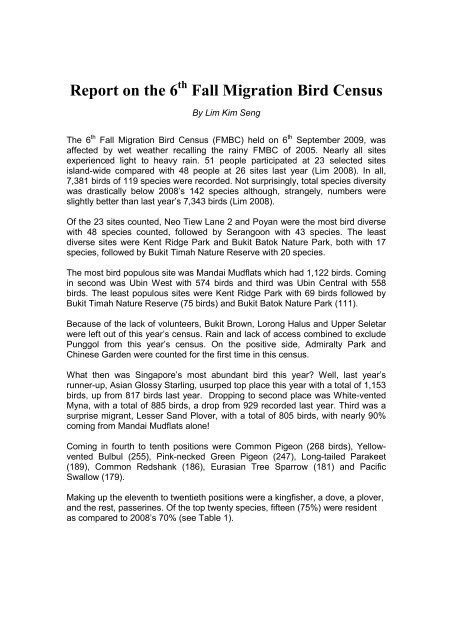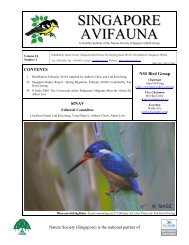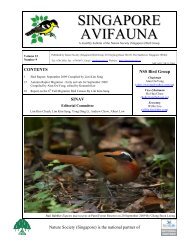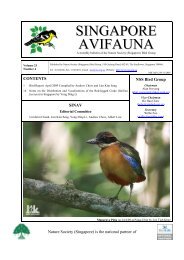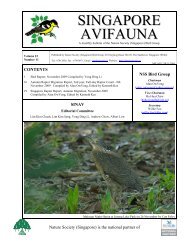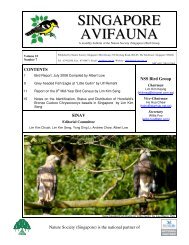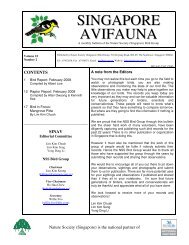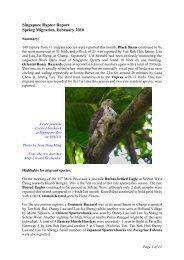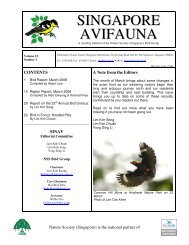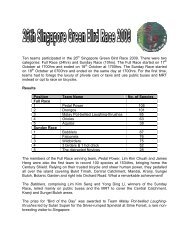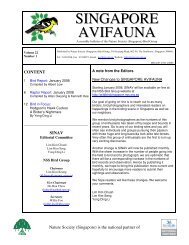Report on the 6 Fall Migration Bird Census - Singapore Bird Group
Report on the 6 Fall Migration Bird Census - Singapore Bird Group
Report on the 6 Fall Migration Bird Census - Singapore Bird Group
You also want an ePaper? Increase the reach of your titles
YUMPU automatically turns print PDFs into web optimized ePapers that Google loves.
<str<strong>on</strong>g>Report</str<strong>on</strong>g> <strong>on</strong> <strong>the</strong> 6 th <strong>Fall</strong> Migrati<strong>on</strong> <strong>Bird</strong> <strong>Census</strong><br />
By Lim Kim Seng<br />
The 6 th <strong>Fall</strong> Migrati<strong>on</strong> <strong>Bird</strong> <strong>Census</strong> (FMBC) held <strong>on</strong> 6 th September 2009, was<br />
affected by wet wea<strong>the</strong>r recalling <strong>the</strong> rainy FMBC of 2005. Nearly all sites<br />
experienced light to heavy rain. 51 people participated at 23 selected sites<br />
island-wide compared with 48 people at 26 sites last year (Lim 2008). In all,<br />
7,381 birds of 119 species were recorded. Not surprisingly, total species diversity<br />
was drastically below 2008’s 142 species although, strangely, numbers were<br />
slightly better than last year’s 7,343 birds (Lim 2008).<br />
Of <strong>the</strong> 23 sites counted, Neo Tiew Lane 2 and Poyan were <strong>the</strong> most bird diverse<br />
with 48 species counted, followed by Serango<strong>on</strong> with 43 species. The least<br />
diverse sites were Kent Ridge Park and Bukit Batok Nature Park, both with 17<br />
species, followed by Bukit Timah Nature Reserve with 20 species.<br />
The most bird populous site was Mandai Mudflats which had 1,122 birds. Coming<br />
in sec<strong>on</strong>d was Ubin West with 574 birds and third was Ubin Central with 558<br />
birds. The least populous sites were Kent Ridge Park with 69 birds followed by<br />
Bukit Timah Nature Reserve (75 birds) and Bukit Batok Nature Park (111).<br />
Because of <strong>the</strong> lack of volunteers, Bukit Brown, Lor<strong>on</strong>g Halus and Upper Seletar<br />
were left out of this year’s census. Rain and lack of access combined to exclude<br />
Punggol from this year’s census. On <strong>the</strong> positive side, Admiralty Park and<br />
Chinese Garden were counted for <strong>the</strong> first time in this census.<br />
What <strong>the</strong>n was <strong>Singapore</strong>’s most abundant bird this year Well, last year’s<br />
runner-up, Asian Glossy Starling, usurped top place this year with a total of 1,153<br />
birds, up from 817 birds last year. Dropping to sec<strong>on</strong>d place was White-vented<br />
Myna, with a total of 885 birds, a drop from 929 recorded last year. Third was a<br />
surprise migrant, Lesser Sand Plover, with a total of 805 birds, with nearly 90%<br />
coming from Mandai Mudflats al<strong>on</strong>e!<br />
Coming in fourth to tenth positi<strong>on</strong>s were Comm<strong>on</strong> Pige<strong>on</strong> (268 birds), Yellowvented<br />
Bulbul (255), Pink-necked Green Pige<strong>on</strong> (247), L<strong>on</strong>g-tailed Parakeet<br />
(189), Comm<strong>on</strong> Redshank (186), Eurasian Tree Sparrow (181) and Pacific<br />
Swallow (179).<br />
Making up <strong>the</strong> eleventh to twentieth positi<strong>on</strong>s were a kingfisher, a dove, a plover,<br />
and <strong>the</strong> rest, passerines. Of <strong>the</strong> top twenty species, fifteen (75%) were resident<br />
as compared to 2008’s 70% (see Table 1).
The top 20 birds of FMBC 2009 are listed below (Table 1).<br />
Ranking Species Total<br />
% of<br />
Total<br />
1 ASIAN GLOSSY STARLING 1153 15.6<br />
2 WHITE-VENTED MYNA 885 12.0<br />
3 LESSER SAND PLOVER* 805 10.9<br />
4 COMMON PIGEON 268 3.6<br />
5 YELLOW-VENTED BULBUL 255 3.4<br />
6 PINK-NECKED GREEN PIGEON 247 3.3<br />
7 LONG-TAILED PARAKEET 189 2.6<br />
8 COMMON REDSHANK* 186 2.5<br />
9 EURASIAN TREE SPARROW 181 2.4<br />
10 PACIFIC SWALLOW 179 2.4<br />
11 HOUSE CROW 174 2.4<br />
12 BLACK-NAPED ORIOLE 172 2.3<br />
13 DAURIAN STARLING* 166 2.2<br />
14 GREY HERON 165 2.2<br />
15 PACIFIC GOLDEN PLOVER* 134 1.8<br />
16 SPOTTED DOVE 126 1.7<br />
17 COMMON IORA 105 1.4<br />
18 COLLARED KINGFISHER 100 1.4<br />
19 BARN SWALLOW* 76 1.0<br />
20 OLIVE-BACKED SUNBIRD 74 1.0<br />
Note: An asterisk (*) denotes a migrant.<br />
Table 1: Top 20 Most Abundant <strong>Bird</strong>s in FMBC 2009<br />
Of <strong>the</strong> 56 nati<strong>on</strong>ally threatened species, 16 or 28% were recorded. This<br />
compares poorly with <strong>the</strong> 36% in 2008 and 45% in 2007. The most numerous<br />
threatened species was <strong>on</strong>ce again Grey Her<strong>on</strong>, 14 th overall, with a count of 165<br />
birds, down from 167 in 2008. Also showing well were Straw-headed Bulbul, 41 st<br />
overall with 29 birds, down from 57 in 2008, Oriental Magpie-robin (22), Oriental<br />
Pied Hornbill (16) and Red Junglefowl (13).<br />
Two globally threatened species were recorded during <strong>the</strong> rain-soaked census.<br />
The first was <strong>the</strong> Straw-headed Bulbul which was present at 5 sites, down from 9<br />
in 2008. Arguably <strong>the</strong> bird of <strong>the</strong> day was a Masked Finfoot which miraculously<br />
appeared at Neo Tiew Lane 2. This very rare n<strong>on</strong>-breeding visitor did not reappear<br />
despite a search of <strong>the</strong> area a few days later.<br />
18 (15%) of <strong>the</strong> 119 species were true migrants as compared with 18% in 2008.<br />
Of <strong>the</strong>se 20, five were am<strong>on</strong>g <strong>the</strong> top twenty birds counted. The o<strong>the</strong>r 13 species<br />
(in order of decreasing abundance) included Little Egret, Comm<strong>on</strong> Sandpiper,<br />
Cattle Egret, Curlew Sandpiper, White-winged Tern, Comm<strong>on</strong> Kingfisher, Blue-
tailed Bee-eater, Marsh Sandpiper, Great Egret, Red-necked Stint, Yellow-billed<br />
Egret, Oriental Reed Warbler and Arctic Warbler. There were quite strangely no<br />
migrant cuckoos or flycatchers.<br />
As in past years, migrant raptors put <strong>on</strong> a no-show and this was probably due to<br />
<strong>the</strong>ir generally late appearance in <strong>Singapore</strong>, as <strong>the</strong> peak seas<strong>on</strong> for <strong>the</strong>m is in<br />
October.<br />
In additi<strong>on</strong> to <strong>the</strong> 119 species recorded, <strong>the</strong>re was also an additi<strong>on</strong>al 4 (7 in<br />
2008) of exotics recorded comprising 17 birds (24 in 2008). These included 9<br />
feral Red Junglefowls, 3 Black Swans, 2 Mute Swans and 3 Great Cormorants.<br />
A total of 1,131 unidentified birds (359 in 2008) was recorded in additi<strong>on</strong> to <strong>the</strong><br />
7,381 birds counted. 1,052 of <strong>the</strong>se (93%) were swiftlets.<br />
The following fabulous people led or assisted in FMBC 2009:<br />
Doreen Ang, Samantha Ang, Dennis Chan, Chan Kim Cheng, MY Chan, Angela<br />
Cheng, Andrew Chow, Geoffrey Davis<strong>on</strong>, C<strong>on</strong> Foley, SC Fang, Willie Foo,<br />
Gerald Francis, Leslie Fung, Margie Hall, Han Yan You, Ho Hua Chew, Ali<br />
Jafaar, Pete J<strong>on</strong>es, Nessie Khoo, Khuan Jia Hui, Maurice Kwan, Danny Lau, Ben<br />
Lee, Jimmy Lee, Lim Kim Keang, Lim Kim Seng, Lim Poh Bee, Low Chwee<br />
Hock, Low Wai Hoe, Ng Chay Tuan, Clarisse Ng, Cyril Ng, Alan Owy<strong>on</strong>g, Phang<br />
Seng Khai, Pui Cui Fen, Gloria Seow, Soh Hui Hiang, John Spencer, Tan Ju Lin,<br />
Tan Kok Hui, Tan So<strong>on</strong> Im, KP Teh, Wee Sau Cheng, Wing Ch<strong>on</strong>g, W<strong>on</strong>g<br />
Chung Che<strong>on</strong>g, Yang Pah Liang, Sunny Yeo, Y<strong>on</strong>g Ding Li, Y<strong>on</strong>g Yik Shih, Yuet<br />
Hsin and Rehan Yusoff.<br />
Thanks <strong>on</strong>ce again to every<strong>on</strong>e who helped ensure <strong>the</strong> success of this year’s<br />
FMBC. Hope you had fun and see you again in 2010!<br />
References<br />
Lim, K.S. (2008). <str<strong>on</strong>g>Report</str<strong>on</strong>g> <strong>on</strong> <strong>the</strong> 5 th <strong>Fall</strong> Migrati<strong>on</strong> <strong>Bird</strong> <strong>Census</strong>. <strong>Singapore</strong><br />
Avifauna 22:9: 21-23.


